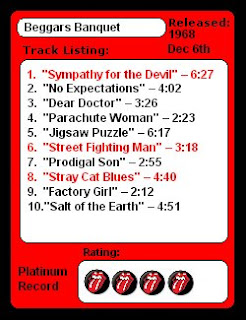 other albums measure up to this one. I have memories of flying down the 401 in the pouring rain blaring “Gimmie Shelter”, howling nights of hazy intoxication where I’ve been able to extract more meaning from “Midnight Rambler” than in any other state of mind, and sad days restricted to the confinements of social obligations where “You Can’t Always Get What You Want” brings some placid sense of hope. And I’ll let you make of it what you will, that “Love in Vain” was on my daily playlist for the first four months of this year.
other albums measure up to this one. I have memories of flying down the 401 in the pouring rain blaring “Gimmie Shelter”, howling nights of hazy intoxication where I’ve been able to extract more meaning from “Midnight Rambler” than in any other state of mind, and sad days restricted to the confinements of social obligations where “You Can’t Always Get What You Want” brings some placid sense of hope. And I’ll let you make of it what you will, that “Love in Vain” was on my daily playlist for the first four months of this year. “Gimmie Shelter” sends a political message, as Jagger vocalizes the need for shelter from the coming storm of worldly devastation and destruction. In his own words he put it: "That's a kind of end-of-the-world song, really. It's apocalypse; the whole record's like that." To get into a writing frame of mind I’ve listened to this album four times in the last two days and countless times in the last few weeks. Today, I dug through my meager collection of vinyl --and as I write these very words my eardrums are pulsating with pleasure from the energy rush. The airwaves in my room resonate while the needle dances through the grooves of the phenomenal composition, --and as the record revolves an injection of the soul of the band, screams: “It’s just a shot away, It’s just a shot away.”
The Stone’s “Love in Vain” is cover of a Robert Johnson tune that has a more polished sound than the original. The sad lyrics, drawn long by Jagger alongside the country blurbs from Richard’s guitar depict the epitome of a yearning and lonesome lover.
 “The Midnight Rambler” was written about the Boston Strangler. It is a fast paced jam that comes to life with Richard’s dangerous guitar riffs and solos. Jagger’s sporadic bellowing into the harmonica tames the country twang of the guitar while Brian Jones’ magnificent splashes on the drums keeps tempo with the quickening bass. This tune would come to be known as a great crowd pleaser at shows as its length and style provide opportunity for instrumental solos.
“The Midnight Rambler” was written about the Boston Strangler. It is a fast paced jam that comes to life with Richard’s dangerous guitar riffs and solos. Jagger’s sporadic bellowing into the harmonica tames the country twang of the guitar while Brian Jones’ magnificent splashes on the drums keeps tempo with the quickening bass. This tune would come to be known as a great crowd pleaser at shows as its length and style provide opportunity for instrumental solos.
The London Bach Choir is featured throughout “You Can’t Always Get What You Want” singing just those words. Skepticism often takes me over when the Stones force out a positive rainbowy tune (*cough…“She’s a rainbow”...) and although this song carries positive message it still seems like a Stones song.
Although this album prides itself on knock-out hits it doesn’t have the same fluid flowing motion of Beggars Banquet.





